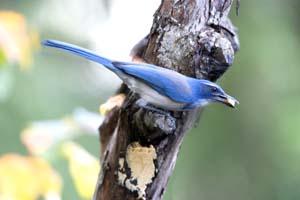Cool Facts about the California Scrub-Jay
and Island Scrub-Jay
Cool Facts about the California Scrub-Jay
- California Scrub-Jays—like many members of the crow and jay family—have a mischievous streak. They’ve been caught stealing acorns from Acorn Woodpecker caches, and some even steal acorns they’ve watched other jays hide. When these birds go to hide their own acorns, they check first that no other jays are watching.
- In 2016 the Ornithologist Union split the Western Scrub-Jay into two species. The California Scrub-Jay and the Woodhouse's Scrub-Jay. The California Scrub-Jay is most common around the Conejo Valley.
- Look closely, and you'll see an intriguing difference between the California Scrub-Jay and its close relative, Woodhouse's Scrub-Jay. The bill of a California Scrub-Jay is stout and hooked, giving it extra power and grip as the birds hammer open acorns in their oak woodland habitats. By comparison, Woodhouse's have thinner, more pointed bills that nimbly reach deep into pinyon pine cones to pull out the pine nuts inside.
- The Western Scrub-Jay’s calls are a hallmark sound of the open West. Some 20 call types are known, and perhaps the best description comes from naturalist W. L. Dawson in 1923: “No masquerader at Mardi Gras has sprung such a cacophonic device upon a quiveringly expectant public. Dzweep, dzweep: it curdles the blood, as it is meant to do.”
- You might see California Scrub-Jays standing on the back of a mule deer. They’re eating ticks and other parasites. The deer seem to appreciate the help, often standing still and holding up their ears to give the jays access.
- The oldest known California Scrub-Jay lived to be at least 15 years, 9 months old. It was banded in California in 1932 and found in 1948 in the same state.
The above information taken from All About Birds.
Cool Facts about the Island Scrub-Jay
- The Island Scrub-Jay lives only on Santa Cruz Island, which means it has the smallest range of any North American bird species.
- The Island Scrub-Jay belongs to the family Corvidae, which includes crows and ravens, are remarkable for their intelligence, memory and curiosity.
- A genetic analysis indicates that this species diverged from its closest relative, the wide spread Western Scrub-Jay about 150,000 years ago.
- Island Scrub-Jays are monogamous and may stay with a mate for their entire lives.
- The Island Scrub-Jay can live as long as twenty years.
- The Island Scrub-Jay is noticeably larger, and a deeper blue color, than its mainland related species of scrub jays.
The above information taken from the National Park Service


